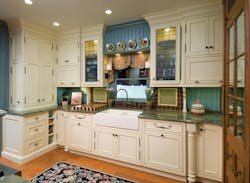K&B Design: Designing the cooking center
A work center or zone is an area where a particular task occurs. Using the center concept is a comprehensive way to design an area that will be used for a certain task. There are three primary centers in the kitchen for food preparation and cleanup: sink, refrigeration, and cooking.
Various secondary centers can be created for certain tasks, such as baking or salad preparation, if the client’s activities and the space allow for it. Other areas or centers may be needed for specific tasks that take place in the kitchen: communications, laundry, or office work.
The approach used to design kitchen work centers should include the following elements: the actual tasks and activities being conducted, the user(s) working in the center, the appliance or fixture that anchors and/or supports the center, required floor space, needed storage for items used, and work surfaces necessary to complete the tasks.
Tasks and activities
Often multiple activities and tasks are occurring in one center. For example, food preparation and cleanup are two primary tasks that occur at the sink. However, other activities, such as taking medications, also occur within the sink center and should be considered.
The tasks and activities may drive decisions about the design requirements that must be met, such as counter height or amount of storage.
Users
Consider the size and abilities of the cook when planning a center. Other user considerations include the number of cooks and the individual tasks they perform. In addition, individuals have different cooking styles that could affect the plan for the kitchen.
The user’s reach-range over a cabinet is an important measurement needed for designing a kitchen. While the average woman can reach a shelf over a base cabinet that is as high as 69 inches, the most comfortable reach-range for most standing users will be between 25 and 59 inches. A more universal reach-range of 15 to 48 inches accommodates standing and seated users.
Another important anthropometric consideration is the horizontal work area. The average person requires at least 30 inches to stand with elbows slightly extended and can use at least 48 inches of work surface with a depth of 16 inches.
Appliances and fixtures
Each center typically contains a basic appliance or fixture for which it is named. However, some tasks use multiple appliances or fixtures.
For example, a range or cooktop may anchor the cooking center and other cooking appliances; that is, a wall oven and a microwave may form secondary cooking centers
An auxiliary sink is another example of a secondary center, which can be combined with a work surface to create a second prep zone.
Floor space and storage
Clearances are required at each center to ensure that cooks can move around effectively in the space and operate the appliances and fixtures. These clearances will be discussed later in this article.
All of the tasks that occur in the kitchen require space to store the things that are used in the center. There are several types of storage designed for placement in the kitchen, and the designer can create special storage systems and products if needed.
Types of kitchen cabinets include wall cabinets, base cabinets, and tall cabinets. These types of cabinets include drawers, shelves, pull-outs, and other interior configurations that can enhance convenience and accessibility to needed items for the user.
Work surface
Countertop space provides the work surface needed to perform tasks in the center. Usually, the countertop surface corresponds to the base cabinet depth and will be 25 inches, depending on the door thickness and countertop overhang needed to clear the cabinetry. Less deep areas are usable for some tasks, because the front 16 inches is the most comfortable work area. The rear 8 inches of the countertop is within reach of most users and is often used for permanent or temporary storage.
While the standard work area is 36-inches high, the ideal work surface height should be planned to be a few inches below the cook’s elbow. A comfortable distance is usually considered to be 3 inches but some tasks, such as kneading bread, might require the arm to be extended in a way that suggests the need for a lower work surface.
Use the client’s measurements and cooking style to help you determine what height is best. While some specialized work heights are helpful to specific users or tasks, standard 36-inch-high counters should also be provided because they are considered a standard height that is useable by most people.
Designing kitchen centers
Some general recommendations for circulation and work aisles are available in the “NKBA Kitchen Planning Guidelines with Access Standards” reference materials.
Each center is discussed separately but comprehensively. The tasks and activities are identified, and requirements associated with completing tasks safely and conveniently are detailed, followed by design recommendations.
Combining centers, planning for adequate storage, and recommendations for dining and serving meals are also presented. The “NKBA Kitchen Planning Guidelines with Access Standards” is important for the safe and comfortable use of the kitchen, and are discussed within the publication.
Universal design concepts and ideas are also presented to encourage designers to think about various user needs while planning the kitchen space.
Thinking broadly about client’s needs, now and in the future, can help you develop a thoughtful design that anticipates changes that will occur over the client’s lifespan. PR
--
This article is excerpted from the NKBA Professional Resource Library volume: Kitchen Planning - Guidelines∙Codes∙Standards, Second Edition by Julia Beamish, PhD, CKE, Kathleen Parrott, PhD, CKE, JoAnn Emmel, PhD, Mary Jo Peterson, CKD, CBD, CAPS, CAASH. Copyright: 2013 National Kitchen & Bath Association; published by John Wiley & Sons, Inc. This material is reproduced with the permission of John Wiley & Sons, Inc.
